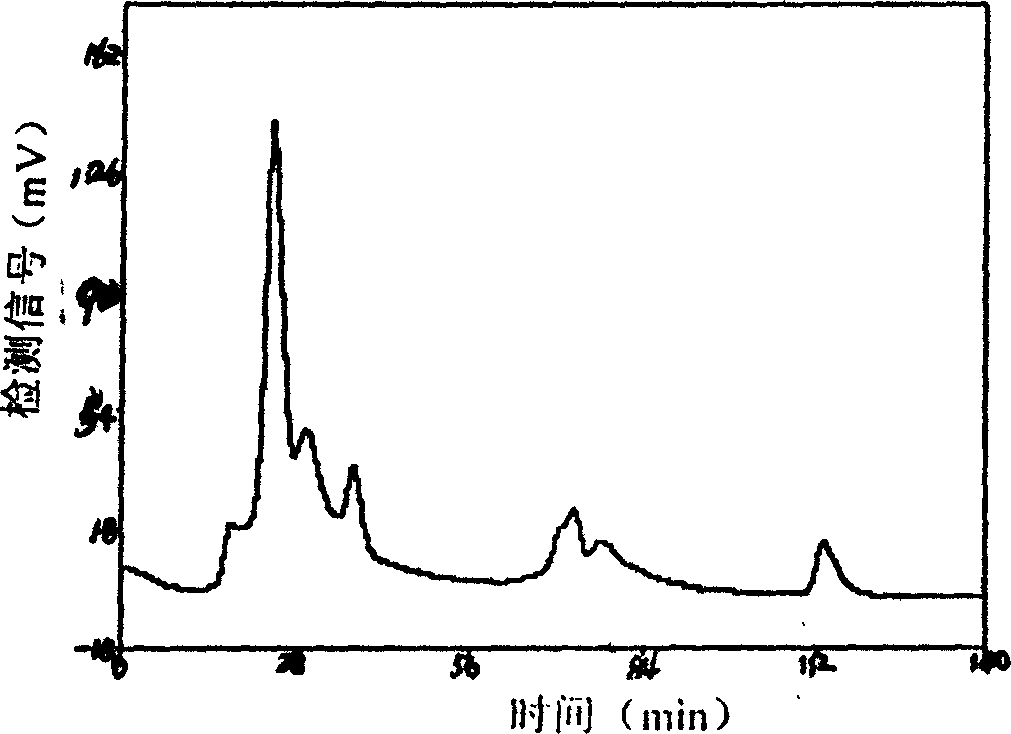Gene-expressed human tissue kallikrein protein separating and purifying method
A kallikrein, separation and purification technology, which is applied in the field of separation and purification of gene expression human tissue kallikrein protein, can solve the problems of large loss, complicated, unsuitable for large-scale production in multi-step operations, and reduce operating costs. , the effect is good, the effect is conducive to preservation
- Summary
- Abstract
- Description
- Claims
- Application Information
AI Technical Summary
Problems solved by technology
Method used
Image
Examples
Embodiment 1
[0044] The separation and purification method of the present invention comprises steps such as centrifugation, ion exchange chromatography, affinity chromatography; Specific process comprises:
[0045] 1. Separation of cell culture supernatant:
[0046] Place the cell culture solution in a polycarbonate centrifuge tube, balance with a Pasteur pipette; centrifuge in a high-speed centrifuge at 4°C, 2000-000r / min for 20-30min.
[0047] Pour the supernatant into a polypropylene funnel with a filter cloth, filter it into a polypropylene container, and store it in cold storage for further ion exchange chromatography.
[0048] 2. Ion exchange chromatography separation:
[0049] DEAE-Sepharose ion exchange chromatography method: chromatographic column: 16mm × 20cm glass packed column; filler: DEAE-Sepharose ion exchange filler; peristaltic pump: miniplus3, Gilson company; detection wavelength: 280nm; flow rate: 5ml / min
[0050] ①Equilibrate the column with 20mM Tris-HCl pH7.6 buffer...
Embodiment 2
[0083] 1. Separation of cell culture supernatant: same as Example 1;
[0084] 2. Ion exchange chromatography separation:
[0085] DEAE-Sepharose ion exchange chromatography method: chromatographic column: 16mm × 20cm glass packed column; filler: DEAE-Sepharose ion exchange filler; peristaltic pump: miniplus3, Gilson company; detection wavelength: 280nm; flow rate: 5ml / min
[0086] ①Equilibrate the column with 20mM Tris-HCl pH6 buffer solution, then dilute the supernatant with water and pump it into the column. Elute with 20mM Tris-HCl pH6 buffer containing 0.1M NaCl, collect fraction a; change to 20mM Tris-HCl pH6 buffer containing 0.3M NaCl for elution after the detected value is lower than 0.05, and collect fraction b. After detection by SDS-PAGE, it was found that human tissue kallikrein was contained in passing through peak, fraction a and fraction b. The result is as Figure 10 As shown, the sixth lane from the left in the figure is fraction b.
[0087] Following steps ...
Embodiment 3
[0090] 1. Separation of cell culture supernatant: same as Example 1;
[0091] 2. Ion exchange chromatography separation:
[0092] DEAE-Sepharose ion exchange chromatography method: chromatographic column: 16mm × 20cm glass packed column; filler: DEAE-Sepharose ion exchange filler; peristaltic pump: miniplus3, Gilson company; detection wavelength: 280nm; flow rate: 5ml / min
[0093] ①Equilibrate the column with 20mM Tris-HCl pH8.5 buffer, then dilute the supernatant with water and pump it into the column. Elute with 20mM Tris-HCl pH8.5 buffer containing 0.1M NaCl, collect fraction a; change to 20mM Tris-HCl pH8.5 buffer containing 0.3M NaCl after the detection value is lower than 0.05, Fraction b is collected.
[0094] Following steps are with embodiment 1.
[0095] Yield 82%. However, the content of impurity proteins in the first step component b detected by SDS-PAGE increased significantly, which brought a lot of trouble to the follow-up work.
PUM
 Login to View More
Login to View More Abstract
Description
Claims
Application Information
 Login to View More
Login to View More - R&D Engineer
- R&D Manager
- IP Professional
- Industry Leading Data Capabilities
- Powerful AI technology
- Patent DNA Extraction
Browse by: Latest US Patents, China's latest patents, Technical Efficacy Thesaurus, Application Domain, Technology Topic, Popular Technical Reports.
© 2024 PatSnap. All rights reserved.Legal|Privacy policy|Modern Slavery Act Transparency Statement|Sitemap|About US| Contact US: help@patsnap.com










